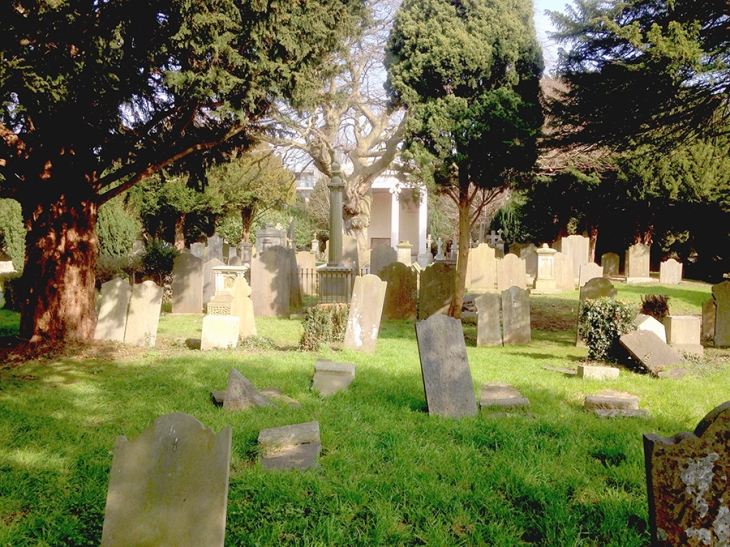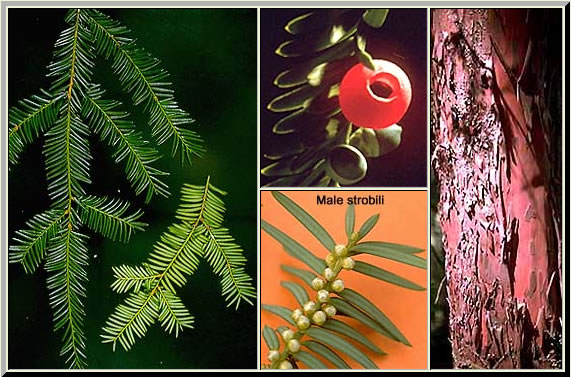
Taxus baccata is a conifer native to western, central and southern Europe, northwest Africa, northern Iran and southwest Asia. It is the tree originally known as yew, though with other related trees becoming known, it may now be known as English yew, or European yew.
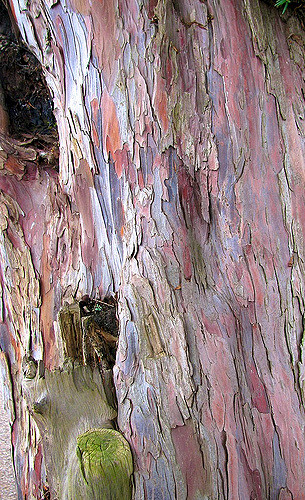
Description: It is a small to medium-sized evergreen tree, growing 10–20 metres (33–66 ft) (exceptionally up to 28 metres (92 ft)) tall, with a trunk up to 2 metres (6 ft 7 in) (exceptionally 4 metres (13ft)) diameter. The bark is thin, scaly brown, coming off in small flakes aligned with the stem. The leaves are flat, dark green, 1–4 centimetres (0.39–1.57 in) long and 2–3 millimetres (0.079–0.118 in) broad, arranged spirally on the stem, but with the leaf bases twisted to align the leaves in two flat rows either side of the stem, except on erect leading shoots where the spiral arrangement is more obvious. The leaves are poisonous.
The seed cones are modified, each cone containing a single seed, which is 4–7 millimetres (0.16–0.28 in) long, and partly surrounded by a fleshy scale which develops into a soft, bright red berry-like structure called an aril. The aril is 8–15 millimetres (0.31–0.59 in) long and wide and open at the end. The arils mature 6 to 9 months after pollination, and with the seed contained, are eaten by thrushes, waxwings and other birds, which disperse the hard seeds undamaged in their droppings. Maturation of the arils is spread over 2 to 3 months, increasing the chances of successful seed dispersal.
Yew trees do not need rich soil but they do need a well drained site, preferably not too exposed to wind or frost. Many yews are single sex, but most Irish yews are female and so bear fruit. Even if the flesh is removed, these may be slow to germinate. The best seeds are those that have been eaten by birds and have passed through them; such bare seeds may be collected from under yew trees. The Yew tree is in fact a good tree for wildlife as birds roost and nest in it.
Longeivity: Taxus baccata can reach 400 to 600 years of age. Some specimens live longer but the age of yews is often overestimated. Ten yews in Britain are believed to predate the 10th century. The potential age of yews is impossible to determine accurately and is subject to much dispute. There is rarely any wood as old as the entire tree, while the boughs themselves often become hollow with age, making ring counts impossible. Evidence based on growth rates and archaeological work of surrounding structures suggests the oldest yews, such as the may be in the range of 2,000 years, placing them among the oldest plants in Europe. One characteristic contributing to yew’s longevity is that it is able to split under the weight of advanced growth without succumbing to disease in the fracture, as do most other trees. Another is its ability to give rise to new epicormic and basal shoots from cut surfaces and low on its trunk, even at an old age.
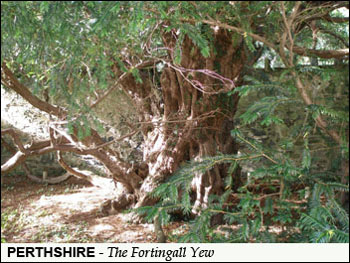
The Fortingall Yew in Perthshire, Scotland, has the largest recorded trunk girth in Britain and experts estimate it to be 2,000 to 3,000 years old, although it may be a remnant of a post-Roman Christian site and around 1,500 years old.

The Yew arch in the Golden bridge Cemetery, Dublin
In Ireland the yew is native and may be found in old woods although it is often seen in the artificial surroundings of estates or churchyards. An evergreen conifer (although an unusual one), yew is a dramatic tree with its dark foliage and red berries encasing a single seed. Reenadina wood on the Muckross Peninsula, Co. Kerry is Ireland’s only native yew wood.
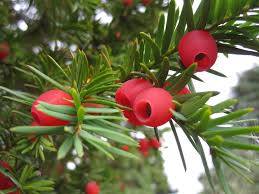
Toxicity: All parts of a yew plant are toxic to humans with the exception of the yew berries (however, their seeds are toxic); additionally, male and monoecious yews in this genus release cytotoxic pollen, which can cause headaches, lethargy, aching joints, itching, and skin rashes; it is also a trigger for asthma. These pollen grains are only 15 microns in size, and can easily pass through most window screens.
The foliage itself remains toxic even when wilted, and toxicity increases in potency when dried. The major toxin within the yew is the alkaloid taxine. Horses have a relatively low tolerance to taxine, with a lethal dose of 200–400 mg/kg body weight; cattle, pigs, and other livestock are only slightly less vulnerable. Several studies have found taxine LD50 values under 20 mg/kg in mice and rats.
Symptoms of yew poisoning include an accelerated heart rate, muscle tremors, convulsions, collapse, difficulty breathing, circulation impairment and eventually cardiac arrest. However, there may be no symptoms, and if poisoning remains undetected death may occur within hours. Fatal poisoning in humans is very rare, usually occurring after consuming yew foliage. The leaves are more toxic than the seed.
Uses:
Wood from the yew is classified as a closed-pore softwood, similar to cedar and pine. Easy to work, yew is among the hardest of the softwoods; yet it possesses a remarkable elasticity, making it ideal for products that require springiness, such as bows. One of the world’s oldest surviving wooden artifacts is a Clactonian yew spear head, found in 1911 at Clacton-on-Sea, in Essex, UK. Known as the Clacton Spear, it is estimated to be over 400,000 years old.
Yew is also associated with Wales and England because of the longbow, an early weapon of war developed in northern Europe, and as the English longbow the basis for a medieval tactical system. The oldest surviving yew longbow was found at Rotten Bottom in Dumfries and Galloway, Scotland. It has been given a calibrated radiocarbon date of 4040 BC to 3640 BC and is on display in the National Museum of Scotland. Yew is the wood of choice for longbow making; the heartwood is always on the inside of the bow with the sapwood on the outside. This makes most efficient use of their properties as heartwood is best in compression whilst sapwood is superior in tension. However, much yew is knotty and twisted, and therefore unsuitable for bow making; most trunks do not give good staves and even in a good trunk much wood has to be discarded.
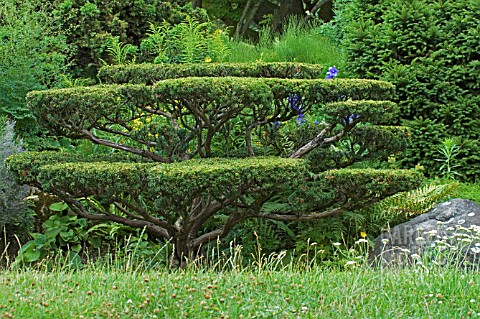 Yew topiary tree cloud
Yew topiary tree cloud
Today European yew is widely used in landscaping and ornamental horticulture. Due to its dense, dark green, mature foliage, and its tolerance of even very severe pruning, it is used especially for formal hedges and topiary. Its relatively slow growth rate means that in such situations it needs to be clipped only once per year (in late summer).
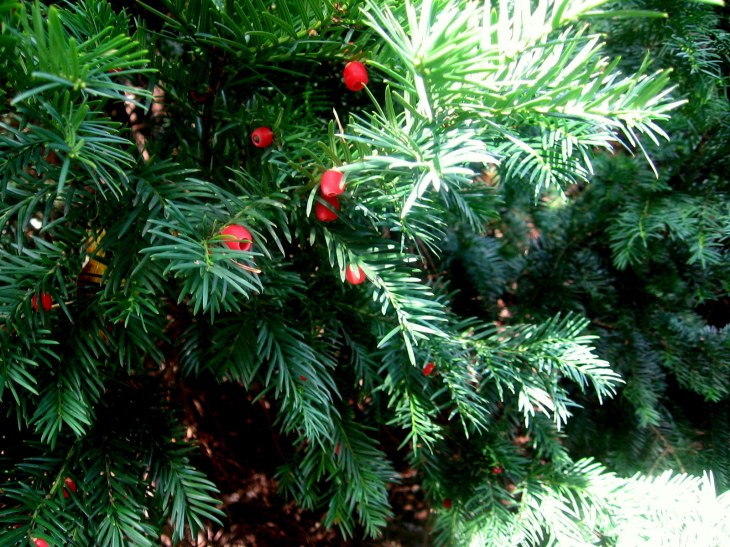 The evergreen Yew with its dark green, needle-like leaves and red berries are toxic to humans and as a result they were identified as the trees of death but were also seen as a symbol of the transcendence of death due to their longevity. The project team were particularly interested in the Yew tree because of the fact that such a highly toxic tree also contained key medicinal components in the fight against various forms of cancer. Compounds found in the bark are nowadays manufactured chemically in the development of the Taxol drug.
The evergreen Yew with its dark green, needle-like leaves and red berries are toxic to humans and as a result they were identified as the trees of death but were also seen as a symbol of the transcendence of death due to their longevity. The project team were particularly interested in the Yew tree because of the fact that such a highly toxic tree also contained key medicinal components in the fight against various forms of cancer. Compounds found in the bark are nowadays manufactured chemically in the development of the Taxol drug.




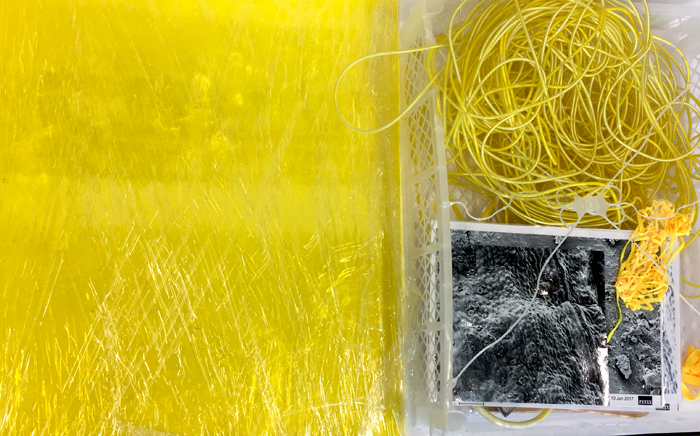













 Yew topiary tree cloud
Yew topiary tree cloud